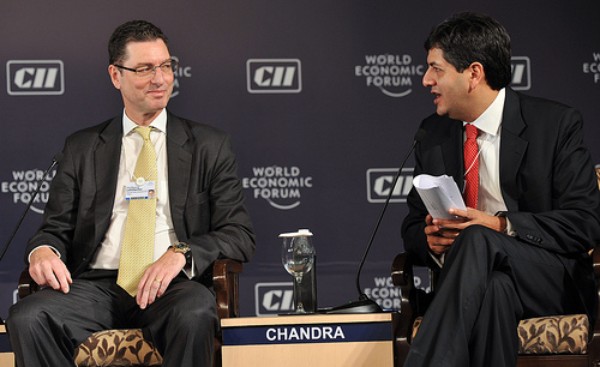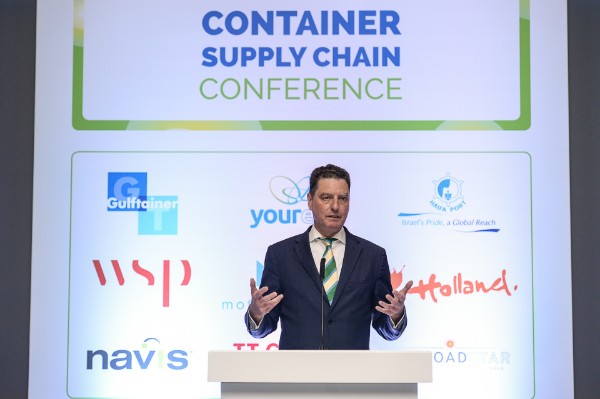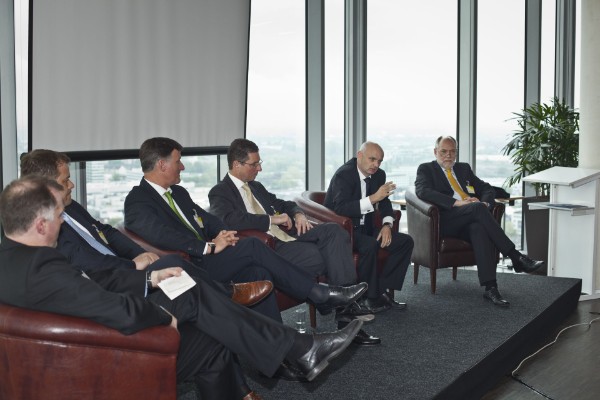PRESS & PUBLICATIONS matrerials with learnings and insights: full list here
Overview: This section provides you with the overview of my public sharing, covering publications, speaking engagements, interviews etc. Please, find other articles/posts on Lehmacher's Blog at WorldPress and Blogspot (German), my LinkedIn author page and Twitter.

Global Strategy: Over the last decades, the relentless rise of China’s export-driven economy has changed the face of world commerce. But China is now in flux as its economy transitions into a new stage of development, rendering the assumptions of yester-year obsolete (2013-09-20 Transport Intelligence - China: Yesterday, Today and Tomorrow). The developed nations will continue to play an important role in the future of global development. However, experts predict that by 2040 the BRIC economies will have outgrown the G7 countries and will be the dominant global markets. There is a high probability that the next growth phase will be led by the BRICs (2009-06-29 GBPT Interview), through a combination of domestic consumption and intra-regional trade flows, in which logistics will be a critical success factor. It is essential that companies are aware of this and align their strategies accordingly (2008-12-05 CEP Research - GeoPost unveils intercontinental growth strategy). Only a clear and consistent strategy, based on a flexible and customer-driven business model enables companies to capture the opportunities as well as mitigate the threats of today’s volatile and rapidly changing world. (2009-12-23 Ti - Special Feature: Interview with Wolfgang Lehmacher). Local proximity and in-depth local knowledge allow for market-driven short-term adaptations (2010-05 tw.direkt - Die Vision vom globalen lokalen Express-Paket-Spezialisten). The world has seen major shifts and one has been the shift of economic driving relevance from the West to the East. Particularly Brazil, India and China are now outperforming major developed economies. Therefore, many companies focus on the BRICs due to their high economic growth potential and the significant business opportunities which this has created; many opt for a partnership approach (2009 Spring inside Laser - Partner Activity). By addressing many of the weaknesses of lower risk strategies, the collaborative business model allows companies to pursue expansion beyond their own reach and ability (2008 World Economic Forum CII India Summit - After the Fallout).

Innovation: The world needs a new form of capitalism as much as we need new forms of democracy. However, the solution is less around new or old systems but more around new and old thinking (2013-08-21 New Economy Summit in Melbourne, Australia). The world’s growing trend towards home care supply represents a major new market for logistics managers as policy makers look to expand home care solutions. Working together, transportation, technology, security companies and logistics businesses can partner with nurse networks, pharmacies and hospitals to provide viable methods of caring for patients. The opportunities for logistics companies to make themselves critical to the delivery and monitoring of such services are immense and already being developed (2013-02-22 JOC - Medical Logistics Offers Opportunities for 3PLs). Innovation has to become part of our every day business life (2012-09-24 Ernst & Young - Growth Through Innovation). Innovation in the transportation industry has centered mainly on speed, efficiency, features and transparency (2010-05 Innovation in the Transportation Industry - Said Business School). Examples of breakthrough innovation in these areas are the container to shorten loading and unloading time, the hub-and-spoke system to achieve efficiencies through the bundling of shipping volumes to and from a central sorting base, the creation of delivery options, such as time definite deliveries, and specialization, for example through the emergence of express parcel products, and the bar-code combined with the scanning of the unique key of each shipment, which enabled the creation of the track-and-trace system, providing a high level of transparency about the status of the specific movement of a merchandise. The Transportation and Logistics industry provides supporting processes and solutions enabling optimising value chains and creating value (2012-03 tw direkt [German] 'out-of-the-box' gedacht).

Smart Seaports: The world's most innovative ports are using 'smart' solutions to improve revenue sustainability. The unique position of ports as facilitators of global and regional trade and often also as integral parts of cityscapes, makes the simultaneous improvement of efficiency, revenues and environmental performance even more desirable (2013-02-12 portstrategy - Working smarter). Many supply chains will become increasingly port-focused. The need for many shippers to prove their sustainability credentials to stakeholders will see the rise of a number of new supply chain models, including those focused on reducing reliance on road and air by making more use of port areas (2012-11-05 Supply Chain Solutions - supply chains likely to become more port-centric).
Sustainability: Transportation is enabler of trade and a carbon intense business. The industry can play an influential role in decarbonization, both in its own operations and through broader supply chain optimisation. Guidelines are required to help work towards a low-carbon supply chain across industries, which have been eleborated and agreed by the World Economic Forum’s Logistics & Transport Industry Group at the Annual Meeting in 2010 (2010-02-15 Carbon Offsets Daily: WEF agrees new carbon emission guidelines). Reducing carbon emission starts with awareness and requieres a holistic and at the same time collaborative approach. (2011-10 tw direct [German] - Nachhaltigkeit in der Supply Chain erfordert End-to-End-Sicht). Countries around the world have adapted a number of different urban transport models in order to meet demand for transport services. The prerequisites for efficient systems are vision, courage as well as technical knowleged and managerial capabilities (2009 World Economic Forum CII India Summit - Transforming Urban Transportation)

Collaborative Model: The franchise concept is an effective tool to integrate collaborative models, ensuring seamless processes and common standards across networks. The collaborative model enables each partner to focus on its core activities and strengths. Although profits are split amongst numerous partners, collaborative models enable expansion beyond the financial and knowledge barriers of individual companies through shared investments and expertise (2012-04-04 eyefor transport - Collaborative networks 'the way forward'). Successfully collaborating with others can enable companies to offer new services with a seamless and coherent customer experience. However, all parties need to accept and live common frameworks and shared operational principles and standards (2012-08-01 Ti - Building through collaboration).
Talent: In the global economy, for an international business to function well, people all over the globe need to be connected and to understand each other, which requires time and effort (2009-01-29 Economist World Dubai - Finance sector moves to stop brain drain). We need to establish, develop and protect the talent pool that will be needed to meet the requirements of increasing globalisation. (2010-11-12 Asean Affairs - Orchestrating effective human resources) The exponential growth of business in China since the late 1970’s to the present has created various challenges and significant developments in terms of human resource management. China is currently moving from a production-based economy to an innovation-based economy, which requires new skills and knowledge.

BRICS: A country’s prosperity, and with it its economic and social development, depends to a large degree on the level of productivity of its logistics sector. Today’s economies are unthinkable without the value and supply chains that modern logistics make possible (2013-08-08 Infrastructure and Logistics - Prerequisites for Sustainable Economic Growth). The BRICS are nations in transformation so by definition it's a bumpy road. Shanghai is very developed, however, when going west we are seeing a different picture. Over the last three decades, the relentless rise of China's export-driven economy has changed the face of world commerce. China remains in flux as its economy transitions into a new stage of development, rendering the assumptions of yester-year obsolete (2013-09-26 International Maritime Information Website - Singapore conference learns China shifts from one paradigm to another). The BRICS are regional powerhouses. They are fast-growing markets and drivers of global growth. It is irrelevant whether the BRICS surpass the economic might of the G7 by 2026, 2050 or never. I believe it will happen, however the key important fact is, they are growing more strongly than the West (2013-09-24 Ti Emerging Markets Logistics Conference (Presentation) - JOC BRICS Still the Markets for Growth).
China: China is one of the BRIC economies offering big opportunities and challenges (2009-04-17 Beijing Review - A fighting chance: How China's small business can survive and thrive in gloomy times) for many including the logistics industry (2008-12-05 Financial Times - Small freight forwarders face failure). The 21st Century could enter history as the Chinese Century. Companies have to find ‘their way’ to capture the China opportunity (2009-05 China Contact [German] - Schneller mit Paketen). For me the most promising options in the Chinese market are those moves that are beneficial and sustainable for all stakeholders. Adopting a sustainable win-win approach requires both sides of any partnership to be very understanding and proactive.

India: Incredible India: a country, and continent, featuring a broad variety of cultures; a BRIC economy with great potential for a promising future. India will play an important role in shaping the future global landscape (2008-11-24 India Economic Summit, Delhi - After the Fallout: A New Global Corporate Landscape?). 270 million people are expected to enter the job market within the next 20 years. This will bring a significant stimulus, not only in terms of business process outsourcing, but also for manufacturing (2010-06-14 Germany Contact India [German] - Tremendous growth opportunities). Today’s dynamics and requirements demand special attention on the way we generate our growth, the way we use the limited resources, and the way we design our life to ensure that today’s needs for products and services are met without jeopardising the needs of future generations. We require solutions supporting a good life for everyone and forever, in India and beyond. Globally and within economies, the key requirement is to understand how the world, how nations, and how organisations make a real difference to the individual life. (2012-01-12 Keynote as Guest of Honour at Symbiosis University, Pune/India).
South Africa: South Africa is a country with an abundant supply of resources, well-developed financial, communications, energy, and transport sectors, and a modern infrastructure supporting an efficient distribution of goods to major urban centres throughout the entire region. Efficient and innovative transportation services are required to constantly suit the customers (2010-06-10 CEP Research - DPD scores in Africa). South Africa is ranked 25th in the world in terms of GDP (PPP) as of 2008.
Korea: The remarkable rise of the Korean nation and economy at the end of last century is closely linked with flag-ship groups like Samsung and LG. The big Korean groups are driving their business and success today largely through innovation, out-performing other players throughout the region and the planet. The Korean government is aware of the importance of the SME sector as a driver of innovation and has therefore launched several initiatives to promote this key sector. In light of the innovative power and success, Korea can be seen as the Silicon Valley of Asia (2012-05-29 hankyung/korea economic daily - “Korea, Asia’s Silicon Valley – A Unique Perspective from Europe”).
The GCC: Recent regional consolidation, occured in the period 2009-2010 has corrected unsustainable developments and projects and is refocussing the private and public sectors on the fundamentals of prosperity and good governance. This makes for solid perspectives in the Region (2011-12 GULF Business - RAK Briefing).
